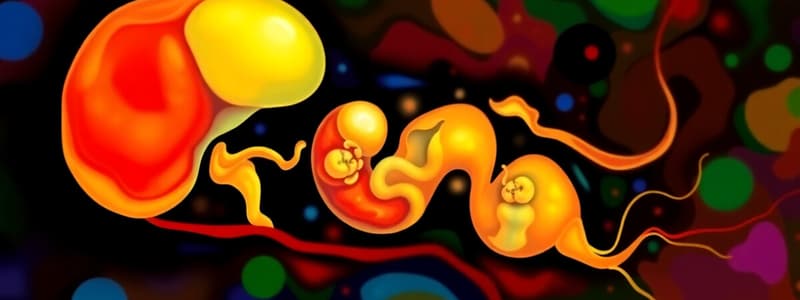Podcast
Questions and Answers
What is the role of epithin in embryonic development?
What is the role of epithin in embryonic development?
- Epithin is involved in the differentiation of the trophoblast.
- Epithin is essential for the compaction of the embryo at the 8-cell stage. (correct)
- Epithin is necessary for the development of the inner cell mass.
- Epithin is involved in the formation of the placenta.
Which of the following genes is crucial for the maintenance of the inner cell mass?
Which of the following genes is crucial for the maintenance of the inner cell mass?
- Oct-4
- Sox-2
- Nanog (correct)
- Cdx-2
Which of the following statements is TRUE about E-cadherin?
Which of the following statements is TRUE about E-cadherin?
- E-cadherin is essential for compaction, and blocking it prevents compaction. (correct)
- E-cadherin is exclusively found in gap junctions.
- E-cadherin is a calcium-independent cell adhesion molecule.
- E-cadherin is only expressed in the outer cell mass of the blastocyst.
What is the relationship between the trophoblast and the embryo?
What is the relationship between the trophoblast and the embryo?
Which of the following is NOT involved in the formation of the placenta?
Which of the following is NOT involved in the formation of the placenta?
What is the significance of 'compaction' during embryonic development?
What is the significance of 'compaction' during embryonic development?
Which of the following is NOT a characteristic of dizygotic twins?
Which of the following is NOT a characteristic of dizygotic twins?
What is the primary purpose of the zona pellucida (ZP) following fertilization?
What is the primary purpose of the zona pellucida (ZP) following fertilization?
What is the significance of the 'decidual reaction' in the context of implantation?
What is the significance of the 'decidual reaction' in the context of implantation?
What is the primary functional difference between the trophoblast and the inner cell mass (ICM)?
What is the primary functional difference between the trophoblast and the inner cell mass (ICM)?
Which of the following is a characteristic shared by Nanog, Oct-4, Sox-2, and Cdx-2?
Which of the following is a characteristic shared by Nanog, Oct-4, Sox-2, and Cdx-2?
Which of the following is NOT a characteristic of parapagus conjoined twins?
Which of the following is NOT a characteristic of parapagus conjoined twins?
What is the key event that marks the transition from maternal gene products to zygote-produced gene products during early development?
What is the key event that marks the transition from maternal gene products to zygote-produced gene products during early development?
What is the primary role of the syncytiotrophoblast during implantation?
What is the primary role of the syncytiotrophoblast during implantation?
What is the main reason why the zona pellucida (ZP) serves as an immunological barrier between the mother and the embryo?
What is the main reason why the zona pellucida (ZP) serves as an immunological barrier between the mother and the embryo?
What is the primary cause of ectopic pregnancies?
What is the primary cause of ectopic pregnancies?
Which of the following is NOT a common location for tubal pregnancies?
Which of the following is NOT a common location for tubal pregnancies?
Which of the following statements accurately describes the process of decidual reaction?
Which of the following statements accurately describes the process of decidual reaction?
Which of the following is NOT a factor that can contribute to infertility due to a failed hatching of the blastocyst?
Which of the following is NOT a factor that can contribute to infertility due to a failed hatching of the blastocyst?
What distinguishes mammalian cleavage from that of lower vertebrates?
What distinguishes mammalian cleavage from that of lower vertebrates?
What is the primary function of the trophoblastic tissues during mammalian embryonic development?
What is the primary function of the trophoblastic tissues during mammalian embryonic development?
What is the significance of the blastomeres being totipotent up to the 8-cell stage?
What is the significance of the blastomeres being totipotent up to the 8-cell stage?
How does the blastocoele form during mammalian embryonic development?
How does the blastocoele form during mammalian embryonic development?
What is the role of cadherin in mammalian embryonic development?
What is the role of cadherin in mammalian embryonic development?
Which of the following statements accurately describes the relationship between cleavage and the development of the blastocyst?
Which of the following statements accurately describes the relationship between cleavage and the development of the blastocyst?
Flashcards
Cleavage
Cleavage
The rapid cell divisions of the zygote that begin ~24 hours after fertilization.
Totipotent Cell
Totipotent Cell
A cell that can develop into a complete organism.
Morula
Morula
A solid ball of cells formed after several rounds of cleavage.
Blastocyst
Blastocyst
Signup and view all the flashcards
Blastomere
Blastomere
Signup and view all the flashcards
Blastocoel
Blastocoel
Signup and view all the flashcards
Cavitation
Cavitation
Signup and view all the flashcards
Cadherin
Cadherin
Signup and view all the flashcards
Epithin
Epithin
Signup and view all the flashcards
Inner Cell Mass
Inner Cell Mass
Signup and view all the flashcards
Trophoblast
Trophoblast
Signup and view all the flashcards
Compaction
Compaction
Signup and view all the flashcards
Oct-4
Oct-4
Signup and view all the flashcards
FGF-4
FGF-4
Signup and view all the flashcards
Monozygotic Twinning
Monozygotic Twinning
Signup and view all the flashcards
Decidual Reaction
Decidual Reaction
Signup and view all the flashcards
Parapagus
Parapagus
Signup and view all the flashcards
Heteropagus
Heteropagus
Signup and view all the flashcards
Blastocyte formation
Blastocyte formation
Signup and view all the flashcards
Zona Pellucida functions
Zona Pellucida functions
Signup and view all the flashcards
Syncytiotrophoblast
Syncytiotrophoblast
Signup and view all the flashcards
Epiblast and Hypoblast
Epiblast and Hypoblast
Signup and view all the flashcards
Ectopic pregnancy
Ectopic pregnancy
Signup and view all the flashcards
Implantation timing
Implantation timing
Signup and view all the flashcards
Human embryos hatch
Human embryos hatch
Signup and view all the flashcards
Study Notes
Cleavage: Early Embryonic Development
- Cleavage is the first major event after fertilization, occurring approximately 24 hours post-fertilization.
- Mammalian cleavage differs from lower vertebrates due to the placental connection. The lack of yolk storage in mammalian eggs necessitates a reliance on maternal nutrients.
- Mammalian eggs are small, allowing for rapid cell divisions that convert the one-celled zygote to a multicellular embryo.
- Cell divisions during cleavage are not perfectly synchronous, resulting in embryos with an odd number of cells.
- Each cell division takes about 12-24 hours.
- No growth occurs during cleavage; the embryo remains at roughly 0.1 mm in diameter.
- The rapid increase in cell number occurs exponentially, following a pattern where the total cell number increases faster than the size.
Cleavage Events
- Cleavage involves rapid mitotic divisions without growth phases.
- Blastomeres (the resulting daughter cells) progressively decrease in size with each division.
- Blastomeres at the 8-cell stage are totipotent, meaning they can develop into a complete organism, crucial for twinning.
- The process culminates in the formation of a morula, a solid ball of cells.
- Subsequently, the morula forms a blastocyst, a hollow ball of cells.
Blastocyst Formation and Cavitation
- Cavitation is the formation of a fluid-filled cavity within the blastocyst known as the blastocoele.
- This process is driven by sodium (Na+) transport mediated by sodium-potassium pumps (Na+/K+).
- Sodium and water accumulate between inner blastomeres, creating the blastocoele.
- Cavitation leads to the differentiation of the blastocyst into an inner cell mass (embryoblast) and an outer cell mass (trophoblast).
Compaction and Cell Adhesion
- Compaction occurs at the 8-cell stage, where blastomeres adhere more tightly together.
- This results in a compact morula structure.
- E-cadherin, a calcium-dependent cell adhesion protein, plays a crucial role in mediating compaction.
- E-cadherin is essential for cell adhesion during compaction. Silencing of the epithin gene prevents compaction.
Blastocyst Differentiation
- The inner cell mass (ICM), also known as the embryoblast, will develop into the embryo proper.
- The outer cell mass, also known as the trophoblast, forms the fetal placental contribution. The trophoblast is crucial for embryonic interactions with the mother and providing protection and delivering nutrients.
Molecular Regulation of Cleavage
- Key genes and proteins regulate early embryonic development.
- Nanog, Oct-4, Sox-2, and Cdx-2 are critical regulators.
- Nanog maintains the integrity of the inner cell mass (ICM).
- Oct-4 (OCT-4) is associated with the pluripotency of cells.
- Sox-2 regulates gene expression in the ICM post-8 cell stage.
- Cdx-2 is essential for trophoblast differentiation.
- LIF (Leukemia Inhibitory Factor) is also important for implantation and early embryonic development.
Implantation
- Implantation begins approximately 6-7 days after fertilization.
- The uterus is prepared by hormones to receive the embryo.
- The blastocyst adheres, penetrates, and becomes embedded in the uterine endometrium (the uterine lining).
- The decidual reaction is a significant part of implantation, involving the transformation of endometrial stromal cells into decidual cells, supporting the implanting embryo.
Twinning
- Dizygotic twins originate from two eggs and two sperm.
- Monozygotic twins originate from a single fertilized egg that splits into two embryos.
- Splitting occurs earlier, around the 8-cell stage.
- Conjoined twins (parapagus, ischiopagus, etc.) represent incomplete splitting.
Zona Pellucida and Hatching
- The zona pellucida plays a critical role in early embryonic development, preventing premature implantation.It restricts entry of sperm and acts as a protective filter.
- The blastocyst hatches from the zona pellucida before implantation occurs.
Ectopic Pregnancy
- Ectopic pregnancies occur when implantation occurs outside the uterus.
- Tubal ectopic pregnancies, where the blastocyst implants in a fallopian tube, are the most common type.
Studying That Suits You
Use AI to generate personalized quizzes and flashcards to suit your learning preferences.




